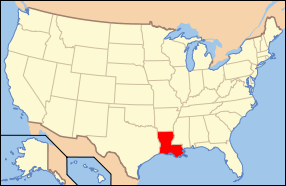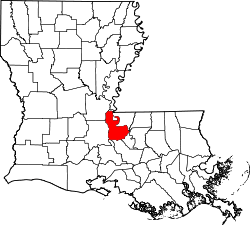Livonia, Louisiana
| Town of Livonia | |
| Town | |
| Country | United States |
|---|---|
| State | Louisiana |
| Parish | Pointe Coupee |
| Elevation | 26 ft (7.9 m) |
| Coordinates | 30°33′37″N 91°33′01″W / 30.56028°N 91.55028°WCoordinates: 30°33′37″N 91°33′01″W / 30.56028°N 91.55028°W |
| Area | 2.4 sq mi (6.2 km2) |
| - land | 2.4 sq mi (6 km2) |
| - water | 0.0 sq mi (0 km2), 0% |
| Population | 1,339 (2000) |
| Density | 741.3/sq mi (286.2/km2) |
| Mayor | Troy Chustz (D) (elected 2012) |
| Timezone | CST (UTC-6) |
| - summer (DST) | CDT (UTC-5) |
| ZIP code | 70755 |
| Area code | 225 |
|
Location of Livonia in Louisiana | |
 Location of Louisiana in the United States | |
Livonia (pronounced Le Vone ya) is a town in Pointe Coupee Parish, Louisiana, United States. The population was 1,339 at the 2000 census. It is part of the Baton Rouge Metropolitan Statistical Area. The town is home to Livonia High School. Its main police agency is the Livonia Police Department.
According to a 2007 Louisiana Legislative report,[1] Livonia made 41.18% of its revenue, an average of roughly $349 per capita, from fines and forfeitures in the 2005 fiscal year.
District 17 State Senator Rick Ward, III, was born in Livonia and resides in Maringouin, in neighboring Iberville Parish.[2]
History
Early history
The area of present-day Livonia has been occupied by several American Indian tribes, including Chitimacha, Houma, Tunica-Biloxi, Attakapas, and Coushatta and the site of the conical Livonia Mound. With a base of 165 feet and nearly 31 (30.7) feet tall, is the tallest of 10 remaining Indian burial mounds in Pointe Coupee Parish. Dated to the Coles Creek archaeological culture (400AD-1100AD) period,[3] the mound sits between La 77 and La 78, 150 feet from Bayou Grosse Tête. A second low-rise unnamed mound (destroyed by the mid-1900s) is located 200 feet southeast and a third was reportedly south of these on the water's edge.[4]
Colonial history
France ruled the Livonia area as part of Louisiana from 1699 to 1763, when the area was ceded to Spain. Spain controlled the area until 1800 when Napoleon took control of Louisiana for France. Some French Canadians migrated to Louisiana earlier, but the majority came between 1755 and 1764 after being expelled from Acadia. Some of the French culture remains in Livonia, as shown by the 2000 census that revealed 5.6% of the parish spoke French, Cajun French, or Louisiana Creole French. The land was sold to the United States in 1803 as part of the Louisiana Purchase.
Foundation
The Post office opened 1846[5] and was named by first postmaster James B. Johnson for his native Livonia, Pennsylvania.[6]
Geography
Livonia is located at 30°33′37″N 91°33′1″W / 30.56028°N 91.55028°W (30.560159, -91.550165).[7]
According to the United States Census Bureau, the town has a total area of 1.8 square miles (4.7 km2), all land.
Demographics
| Historical population | |||
|---|---|---|---|
| Census | Pop. | %± | |
| 1960 | 430 | — | |
| 1970 | 611 | 42.1% | |
| 1980 | 980 | 60.4% | |
| 1990 | 970 | −1.0% | |
| 2000 | 1,339 | 38.0% | |
| 2010 | 1,442 | 7.7% | |
| Est. 2015 | 1,410 | [8] | −2.2% |
As of the census[10] of 2000, there were 1,339 people, 502 households, and 380 families residing in the town. The population density was 741.3 people per square mile (285.6/km²). There were 545 housing units at an average density of 301.7 per square mile (116.3/km²). The racial makeup of the town was 91.04% White, 8.51% African American, 0.15% Asian, and 0.30% from two or more races. Hispanic or Latino of any race were 0.60% of the population.
There were 502 households out of which 40.4% had children under the age of 18 living with them, 63.9% were married couples living together, 7.8% had a female householder with no husband present, and 24.3% were non-families. 21.5% of all households were made up of individuals and 11.0% had someone living alone who was 65 years of age or older. The average household size was 2.67 and the average family size was 3.10.
In the town the population was spread out with 28.2% under the age of 18, 8.6% from 18 to 24, 32.3% from 25 to 44, 21.4% from 45 to 64, and 9.5% who were 65 years of age or older. The median age was 33 years. For every 100 females there were 96.0 males. For every 100 females age 18 and over, there were 93.0 males.
The median income for a household in the town was $37,000, and the median income for a family was $42,721. Males had a median income of $36,685 versus $22,036 for females. The per capita income for the town was $16,756. About 7.9% of families and 13.2% of the population were below the poverty line, including 13.4% of those under age 18 and 24.8% of those age 65 or over.
Culture
The town is host to the annual Livonia Lions Club Mardi Gras parade which is held the weekend before Mardi Gras Day.
Probably one of Livonia's most famous international tourists was Edward VIII, the Duke of Windsor, who arrived by train following the Mardi Gras celebration in New Orleans, Louisiana in 1950.[11]
See also
References
- ↑ http://www.thenewspaper.com/rlc/docs/2007/la-speedtraps.pdf Louisiana speed traps
- ↑ "Senator Rick Ward, III". labi.org. Retrieved July 17, 2013.
- ↑ archaeological dating- Retrieved 2014-05-29
- ↑ Livonia mound- p. 2-3; Retrieved 2014-05-29
- ↑ Livonia Post Office- Retrieved 2014-05-31
- ↑ Naming of Livonia Post Office- Retrieved 2014-05-31
- ↑ "US Gazetteer files: 2010, 2000, and 1990". United States Census Bureau. 2011-02-12. Retrieved 2011-04-23.
- ↑ "Annual Estimates of the Resident Population for Incorporated Places: April 1, 2010 to July 1, 2015". Retrieved July 2, 2016.
- ↑ "Census of Population and Housing". Census.gov. Retrieved June 4, 2015.
- ↑ "American FactFinder". United States Census Bureau. Retrieved 2008-01-31.
- ↑ Lockhart, John M. "Did You Know?", The Riverside Reader, January 14, 2008, p. 1
